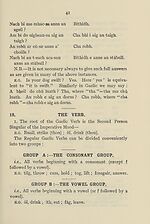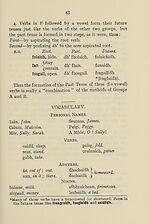Download files
Complete book:
Individual page:
Thumbnail gallery: Grid view | List view

42
Tense Formation.
2. The Gaelic Verbs—with the exception of tha, bheil,
is—have no simple Present Tense.
E.G. I struck, Bimail mi : a definite verbal form. But,
‘ I strike ’ is rendered into Gaelic thus :—
*Tha mi a’ bualadh= literally, I am at striking. The
present tense (so called), then, is a “Compound” of the
verb * Bi ’ and the ‘ Verbal Noun ’ of the verb to be trans¬
lated.
3. Bet us, then, take for the present discussion the three
Principal Parts of the Verb, namely :
The Root Verb, The Past Tense, and
The Future Tense.
In Group A, the past tense is formed by aspirating the
root verb, and the future tense by adding ‘ idh ’ to the root.
Thus : Roots.
tilg throw,
till, return,
freagair, answer
Past. Future.
thilg. tilgidh.
thill. tillidh.
fhreagair. freagairidh
(|freagraidh).
Note that, when the vowel of the root verb is broad
(a, o, u), the future ending is ‘ aidh.’
E.G. gehrr, cut. ghearr. gearraidh.
cum, hold. chum. cumaidh.
tog, lift. thog. togaidh.
Group B. These form the past tense by prefixing dh’
to the root, and the future tense just like Group A.
E.G. ith, eat. dh’ ith. ithidh.
imich, go. dh' imich. imichidh.
but, 61, drink. dh’ 61. olaidh.
* a', standing for ag, is sign of present participle, ag being a form
of preposition, aig = at. Thus, ag bualadh, for euphony, a' bualadh —
at striking (a-striking). Ag is used before initial vowel verbs, as
ag 61 = at drinking .
f Many of those verbs have a syncopated (or shortened) form in
the future tense, like freagraidh, and fosglaidh.
Tense Formation.
2. The Gaelic Verbs—with the exception of tha, bheil,
is—have no simple Present Tense.
E.G. I struck, Bimail mi : a definite verbal form. But,
‘ I strike ’ is rendered into Gaelic thus :—
*Tha mi a’ bualadh= literally, I am at striking. The
present tense (so called), then, is a “Compound” of the
verb * Bi ’ and the ‘ Verbal Noun ’ of the verb to be trans¬
lated.
3. Bet us, then, take for the present discussion the three
Principal Parts of the Verb, namely :
The Root Verb, The Past Tense, and
The Future Tense.
In Group A, the past tense is formed by aspirating the
root verb, and the future tense by adding ‘ idh ’ to the root.
Thus : Roots.
tilg throw,
till, return,
freagair, answer
Past. Future.
thilg. tilgidh.
thill. tillidh.
fhreagair. freagairidh
(|freagraidh).
Note that, when the vowel of the root verb is broad
(a, o, u), the future ending is ‘ aidh.’
E.G. gehrr, cut. ghearr. gearraidh.
cum, hold. chum. cumaidh.
tog, lift. thog. togaidh.
Group B. These form the past tense by prefixing dh’
to the root, and the future tense just like Group A.
E.G. ith, eat. dh’ ith. ithidh.
imich, go. dh' imich. imichidh.
but, 61, drink. dh’ 61. olaidh.
* a', standing for ag, is sign of present participle, ag being a form
of preposition, aig = at. Thus, ag bualadh, for euphony, a' bualadh —
at striking (a-striking). Ag is used before initial vowel verbs, as
ag 61 = at drinking .
f Many of those verbs have a syncopated (or shortened) form in
the future tense, like freagraidh, and fosglaidh.
Set display mode to:
![]() Universal Viewer |
Universal Viewer | ![]() Mirador |
Large image | Transcription
Mirador |
Large image | Transcription
| An Comunn Gàidhealach > An Comunn Gàidhealach Publications > Elementary course of Gaelic > (54) |
|---|
| Permanent URL | https://digital.nls.uk/196027452 |
|---|
| Description | This contains items published by An Comunn, which are not specifically Mòd-related. It includes journals, annual reports and corporate documents, policy statements, educational resources and published plays and literature. It is arranged alphabetically by title. |
|---|
| Description | A collection of over 400 items published by An Comunn Gàidhealach, the organisation which promotes Gaelic language and culture and organises the Royal National Mòd. Dating from 1891 up to the present day, the collection includes journals and newspapers, annual reports, educational materials, national Mòd programmes, published Mòd literature and music. |
|---|---|
| Additional NLS resources: |
|

